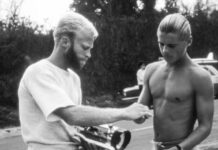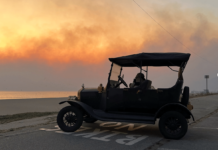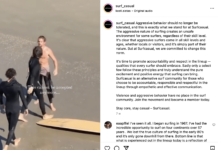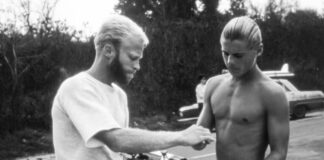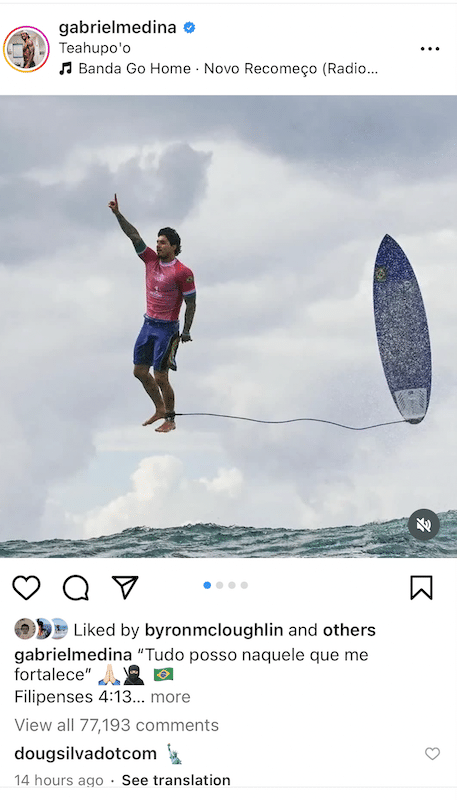
Nearly every man met the challenge head on. Nearly every man.
Who’d have thought the Olympics could provide the most entertaining day of men’s professional surfing in memory?
Teahupoo was huge, cerulean blue, and fearsome. It looked exactly like the deadly paradise it had been hyped to be.
Nearly every man met the challenge head on. Nearly every man.
TLDR: if you missed today’s action, I implore you to re-watch heats four, five and six, at the least. The sixth, between Brazil’s Joao Chianca and Morocco’s Ramzi Boukhiam, may well belong somewhere in the pantheon of greatest ever.
I missed the opener between Jordy Smith and Peru’s Alonso Correa, and the convoluted process of getting a stream means no chance of a replay at this early stage. Please let me know if I missed anything of note, beyond the fact a virtually unknown surfer put paid to Jordy’s Olympic dreams.
I did catch the second heat between Japan’s Reo Inaba and two-time world champ, Filipe Toledo. But we’ll return to this.
Suffice to say that when Griffin Colapinto and Kauli Vaast hit the line-up for heat three, their smoothness and composure was such stark contrast to the previous heat it was like being bathed in blood-warm water by a bevy of beautiful handmaidens.
Both men were selective, catching just five waves between them, but local boy Vaast chose the best brace, edging out Colapinto, who might have won three or four of the other heats today.
Vaast had looked very stern on the boat before the heat. His comfort in the line-up here is a certainty, so we might reasonably assume the occasion was the cause for tension. This seemed to be evidenced by an exuberant claim for a chunky wave that he was not especially deep on.
On paper alone, I was not especially hyped by the prospect of the next heat between veteran Frenchman, Joan Duru, and a surfer representing Mexico (but entirely unknown to me), Alan Cleland.
More fool me. And from this day forth I will take note of the name.
Cleland was brash and swaggering, and his surfing backed it up. A no-hand barrel was the greatest example of this. If he’d been dressed in a pair of Billabong rising sun boardies, we might have been forgiven for thinking the Second Coming was upon us.
But he came up against Duru in the form of his life. The Frenchman expertly threaded deep, technical barrels to earn a pair of nines and a heat win which was ultimately deserved, yet not as comfortable as the scoring discrepancy might suggest.
And then came the Medina show.
His level of excitement to be unleashed upon these conditions was palpable, and the 9.90 he was awarded for his second wave should really have been a ten. Two judges agreed.
It was a perfect wave, the stuff posters are made of. He hung onto the drop by the tips of his toes, committing his entire soul to the make. Flying out with the spit, he launched off the back of the wave, body straight and torqued, as if he was walking through the air.
The score made mockery of the history of high nines.
“A beautiful, life-threatening wave,” said Chris Cote.
After this he was rampant, even grinning from ear to ear as he was plucked from the melee of a non-make by the Tahitian water patrol. He backed up with a mid-seven, and the heat was over.
Medina lives for days like this.
All that power, all that love of the game. On days like today it comes to the fore.
If you’re one of his few remaining detractors who professes to love surfing, well, you should hang your head in shame and set fire to your wetsuit.
In truth, he deserved a better opponent than an out-of-sorts Kanoa Igarashi, but it wouldn’t have mattered. The only man in the world who can defeat Gabriel Medina at Teahupoo on days like today is himself.
Somewhere around this time I noted the cleanliness of the broadcast. There were no breaks, no missed waves, no irrelevant interviews, and no clown princes spruiking ladders or noodles.
The surfing simply flowed in all its glory, and that was enough.
And it would have been criminal to interrupt any second of the heat between Joao Chianca and Ramzi Boukhaim.
It was an exhibition of such quality and commitment that, truly, no man deserved to lose.
Both held high nines backed up by eights, and both threw away further eights.
Boukhaim looked like he’d flipped the heat late with a 9.70, the highest score of the match, but Chianca was undeterred, turning the heat with an 8.80 as the clock ebbed away.
Really, you should just watch it and savour it for yourself.
But the story of this heat is much deeper than what we saw in the water.
Boukhaim, the veteran who battled for years to make the WCT, only to injure his ankle in the days prior to the first event and miss the whole season.
Then Chianca, who is only now returning to competition after being pulled unconscious from the water at Backdoor prior to the start of this year’s Tour.
In these men, there is nothing if not total commitment.
It was hard to imagine we could better this heat, and that turned out to be the case.
The match-up between Jack Robinson and John Florence held promise of explosive beauty for fans of professional surfing, but as is so often the way with these marquee match-ups, it failed to flare.
Both men came out primed for tens or zeros. They blew two waves apiece to begin before Robinson found a little rhythm to take the win with just mid-range scores.
Florence failed to make even double figures in his heat total, as unlikely a scenario as you might imagine given the conditions. Perhaps one of his heavy beatings early in the heat was to blame.
The waves were a little less perfect and a little less consistent throughout the match-up. The irony of the two best waves we’d seen all day rolling through unridden in the seconds after it finished was not lost.
After this the wind turned, strengthened and ruined the party. Ethan Ewing bettered Connor O’Leary and the comp was called off for the women who had been slated to follow. More’s the pity.
And so what of Filipe Toledo? What did our two-time world champ do on this day of days?
Well, for a long while it looked like he might repeat his infamous zero point heat total, but as it was he notched a 2.46. Three waves attempted, none critical or close, the highest coming in at a 1.43.
He was roundly trounced by the committed Japanese surfer, Reo Inaba, who deserved the victory regardless of Toledo’s no-show.
Inaba charged and grinned throughout. Even when he was ragdolled by the heaviest wave in the world, he still came up smiling.
Toledo, by contrast, was locked back into his familiar grimace, looking like he’d rather be anywhere else in the world. Ideally 24 hours in the past, posting an obscene number of Instagram stories highlighting his waves from yesterday.
But pay for his hubris he did.
With all sincerity, I hope he is ok, because I can scarcely imagine a greater swing from high to low.
Yesterday, his demons had been vanquished, silenced and sent back to that dark chamber in the pit of his soul.
Today, they are back upon his shoulder, wailing and cackling into the shot blood of his eyeballs.
And I fear that when it’s all said and done, it won’t be two world titles and some of the most dynamic surfing ever done that is Filipe Toledo’s legacy, but simply a handful of waves he refused to paddle for.


